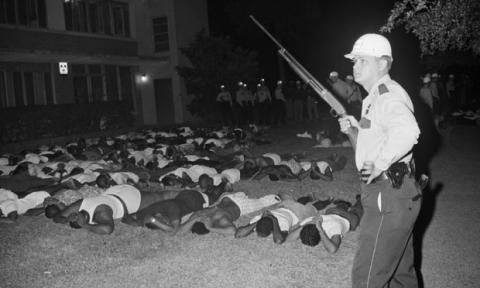All over the US, we are witnessing the dawn of a truth and reconciliation movement. There is a rising chorus of voices that is helping us to collectively face an epidemic of racial violence, expose its deep historical roots, and stop it.
At this stage, there’s no centralized national truth and reconciliation body of the sort we saw in South Africa after the fall of apartheid. Instead, these expressions emanate from local, community-based and grassroots groups that are self-organizing rather than following the directives of a high-level governmental entity. For now, letting bottom-up, organic initiatives lead the way is a good thing.
To move toward a reconciled America, we have to do the work ourselves.
There’s a lot that needs to be done. According to a recently released report, Lynching in America, by acclaimed civil rights attorney Bryan Stevenson and the Equal Justice Initiative, there were a total of 3,969 lynchings during the epidemic that took place in 12 southern states from 1877 to 1950. That’s about 700 more than research previously indicated.
The report describes in gruesome detail the castration, gouging out of eyes, boring of holes into bodies to pull out “quivering flesh”, burnings at the stake, and other grisly rituals performed in these homespun public spectacles attended by white people in the thousands. Ruling elites and entire families would spend the day picnicking on deviled eggs, lemonade and whiskey in a carnival-like atmosphere while this took place. Attendees posed next to twisted hanging bodies for pictures to be purchased as souvenir postcards. Mutilated fingers and ears were given out as gory mementos.
According to the report, today’s racialized mass incarceration and capital punishment, along with deadly police practices, are the progeny of racial terror lynching. Contemporary youth movements responding to police violence – the Millennial Activists United, Black Lives Matter, the Dream Defenders and others – lend a heightened sense of urgency to the task of ending these horrific practices.
This report is an unsettling and powerful current in the rising wave of truth-telling and reconciliation. Stevenson intends to honor those who were lost by installing historical markers to help transform the lynching sites into places of peace and healing. There are few, if any, such memorials in the 12 states studied, although plaques and statues dedicated to confederate soldiers and upholders of slavery abound.
Descendants of the DeWolfs, once the nation’s largest slave owning families, are also facing their history and acknowledging responsibility for the massive harm they caused. Their book, film and travels to communities across the nation are helping to catalyze racial dialogue, action and healing. They are joined in their efforts by Karen Branan, a journalist who discovered that her great-grandfather presided over the lynchings of three black people in 1912, and has been speaking up about her hidden family secret.
Elsewhere, entire communities are attempting to come to terms with their past. The Greensboro, North Carolina Truth and Reconciliation Commission exposed the truth of the 1979 massacre of anti-racism activists by the Ku Klux Klan, in which the local police was complicit, by collecting testimonies from survivors, Klan members and police. They called for official apologies, public monuments, museum exhibits, a community justice center, a police review board and anti-racism training for police.
The Mississippi Truth Project unearthed racially motivated violence and the complicity of public officials between 1945 and 1975. Their Welcome Table initiative creates safe spaces where members of racially divided communities can come together to face history and engage in truth-telling and collective action.
Northeastern University Law School’s Civil Rights and Restorative Justice Institute exposes the truth about civil rights-era murders in the south, promoting official apologies, state pardons, memorialization activities, truth proceedings and institutional reform. The Mass Slavery Apology initiative engages in truth-telling to educate the public about the legacy of slavery and build support for reparations.
These are all expressions of a larger truth and reconciliation movement underway that acts on social justice levels while also affirming the need for deep spiritual, emotional, dialogic, and relational work. Our nation needs this kind of holistic medicine in large doses to finally begin to transform cycles of racialized historical trauma so we will no longer be doomed to perpetually repeat them.
This process of reconciliation is messy and challenging. But it is also a source of hope. Through deep dialogue, truth-telling and taking action to make things as right as possible, we can forge new futures based on the mutual recognition of one another’s humanity. In this way, we can finally leave our past behind us.


Spread the word